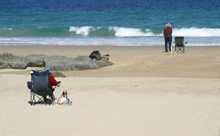
It’s the season for snowbirds: those weather-weary Canadians who pass their winters in southern climes. But spending months avoiding the cold isn’t as simple as packing a bag and hitting the road.
If you work with snowbirds, there are several important issues you should review with your snowbird clients before they head south, including:
– Crossing the border
The new border services agreement, through which Canada and the U.S. will share information about people who cross the joint border, has been delayed until July 2015. But snowbirds still need to have their facts straight when crossing into the U.S., according to Brian Wruk, certified financial planner and founder of Transition Financial Advisors Group Inc. in Gilbert, Ariz.
Wruk advises his clients to be prepared to tell precisely when and how they are returning to Canada when speaking with border officials, and to have supporting documentation if possible.
“[U.S. officials] want to make sure you’re coming back [to Canada],” Wruk says. “That’s what they’re most interested in.”
Wruk advises snowbirds to carry a kit of documents that prove that Canada is their home. As well as a passport, copies of utility bills, property deeds and contact information for family members can help to prove that your clients have no intention of overstaying their welcome in the U.S.
– Tracking time in the U.S.
Snowbirds also should be aware of the formula for determining whether they are considered a U.S. resident for tax purposes. The limit for non-residents to stay in the U.S. each year is set at 182 days. (If a snowbird is forced to spend time in a U.S. hospital or is detained, Wruk adds, those days are not counted toward his or her total.)
Another measure of tax status, substantial presence, is calculated by examining a visitor’s time in the U.S. over a three-year period. Many snowbirds would fail this test, according to Wruk, but filing a specific tax form (Form 8840) with the U.S. Internal revenue Service (IRS) will prove that the visitor has a “closer connection” with Canada and thus should be exempt from paying U.S. taxes.
If your snowbird clients aren’t sure how many days they spent in the U.S. over the past three years, they can check online, says Terry Ritchie, director, cross-border wealth services, with Cardinal Point Wealth Management LLC in Calgary. Your client can register for an I-94 Customs and Border Protection (CBP) number (via Google: “Get I-94”), then be able to check their tally whenever they like. This also means the CBP has the exact number, too, so fudging the number in order to stay south a bit longer is not a good idea.
– Property owners
Snowbirds who own vacation homes in U.S. need special planning. For example, these clients need to protect this property from taxes when they die. Wruk recommends that these clients set up beneficiary deeds for their U.S. property. For $200-$400, these documents allow Canadian owners of U.S. property to assign a beneficiary so the property can pass, upon the owner’s death, without probate. Not every state allows this option, however, so consult American lawyers to determine if this is the best step. If the property is in a state in which beneficiary deeds are not permitted, snowbirds need to ensure a co-ordinated approach to their U.S. and Canadian wills.
“I recommend that people have a very narrowly written will in the U.S. to govern just that property,” Wruk says. “And you need to ensure that the Canadian will excludes this property.”
– Selling property
Canadians also should be aware of the tax implications of selling property in the U.S., Ritchie says. If your snowbird clients sell or rent out U.S. properties, they have to file Form 1040NR with the IRS, which reports capital gains or losses on U.S. property owned by non-residents.
Your client is obliged to report capital gains on a sale of U.S. property in both countries, Ritchie adds, but the Canada Revenue Agency will provide a foreign tax credit for the Canadian tax return to offset the U.S. taxes paid.
Even if a property in the U.S. is sold at a loss, your Canadian client might have to report a capital gain in Canada after adjusting for the currency exchange rate. To complicate things further, Ritchie says, if a Canadian sells a U.S. property for proceeds greater than US$300,000, 10% of the sale price could be withheld and submitted to the IRS (for next year’s taxes) before the deal closes. If your snowbird client is convinced that there hasn’t been a gain on such a property, he or she can file a specific IRS form (8288-B), which asks to be exempt from this payment – but it won’t happen automatically, warns Ritchie: “If you’re not proactive, the escrow agent is going to withhold it.”
All Canadians selling property in the U.S., Wruk adds, need an individualized taxpayer identification number from the IRS.
– Health coverage
Snowbirds must be aware of the residence rules outlined by their provincial health-care programs. If your clients live out of province for longer than the limit set by their province, says Ritchie, they could become ineligible to access care when they return home.
Snowbirds also should buy additional health insurance, which can be expensive if they are dealing with certain medical conditions.
© 2014 Investment Executive. All rights reserved.